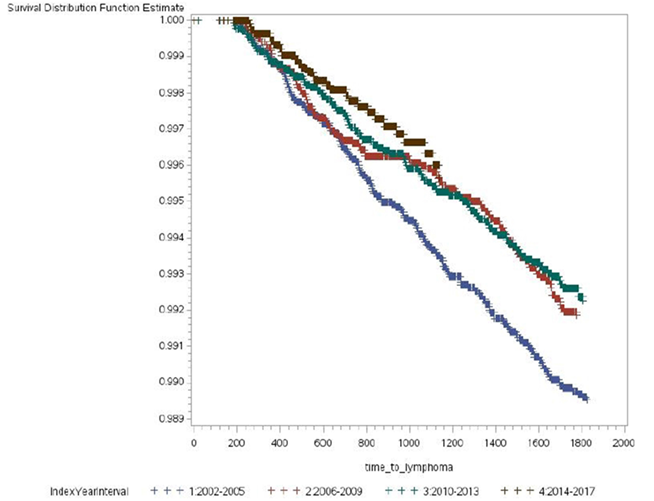Session Information
Date: Monday, October 22, 2018
Session Type: ACR Poster Session B
Session Time: 9:00AM-11:00AM
Background/Purpose: Past epidemiologic studies have consistently demonstrated a link between Rheumatoid Arthritis (RA) and lymphomas and have posited that high systemic inflammatory activity is a major risk determinant for lymphomagenesis. In 2010, RA treatment guidelines recommended a treat to target (T2T) approach, but the impact of this approach on lymphoma incidence remains poorly understood. This study examined and compared temporal trends in lymphoma incidence in US veterans with RA versus veterans with osteoarthritis (OA), who are not expected to be impacted by T2T implementation.
Methods: Patients with RA or OA were identified in the Veteran Affairs (VA) Corporate Data Warehouse. The RA cohort included patients with 2 or more RA diagnostic codes at least 6 months apart during 2002-2017, with at least one visit in a rheumatology clinic. We used a similar algorithm to identify OA patients. Patients with other autoimmune diseases like lupus, celiac disease, inflammatory bowel disease were excluded. Lymphoma incidence was identified from the VA Central Cancer Registry. We used proportional hazards regression to compare the relative hazard of lymphoma for patients diagnosed with RA or OA during 2002-2005, 2006-2009, 2010-2013, and 2014-2017, while controlling for age, sex, and race. Censoring events included death or end of follow-up, with a maximum follow-up period of 5 years for each patient.
Results: We identified 105,297 patients diagnosed with OA and 50,298 diagnosed with RA. We observed 356 RA patients and 558 OA patients with lymphoma onset within 5 years of initial fulfillment of RA or OA algorithm. The hazard of lymphoma decreased significantly for patients diagnosed with RA during 2014-2017 relative to patients diagnosed in 2002-2005 (Hazard Ratio [HR] = 0.63; p=0.02) (Figure 1). Among OA patients, the hazard of lymphoma also decreased, although the decrease was not statistically significant (HR=0.74; p=0.09). There was no significant difference in trends between the OA and RA patients (p=0.55).
Conclusion: We observed a decline in lymphoma incidence in RA patients after adjusting for race, age, and sex, although the decline was not significantly different between OA and RA veterans.
Figure 1. Kaplan-Meier curves showing time to lyphoma for RA patients stratified by the year of diagnosis. 
To cite this abstract in AMA style:
Singh N, Gao Y, Beck B, England BR, Cannon GW, Mikuls TR, Curtis JR, Link B, Lynch C, Field E, Vaughan-Sarrazin M. Trend of Lymphoma Incidence in US Veterans with Rheumatoid Arthritis Vs Osteoarthritis: 2002-2017 [abstract]. Arthritis Rheumatol. 2018; 70 (suppl 9). https://acrabstracts.org/abstract/trend-of-lymphoma-incidence-in-us-veterans-with-rheumatoid-arthritis-vs-osteoarthritis-2002-2017/. Accessed .« Back to 2018 ACR/ARHP Annual Meeting
ACR Meeting Abstracts - https://acrabstracts.org/abstract/trend-of-lymphoma-incidence-in-us-veterans-with-rheumatoid-arthritis-vs-osteoarthritis-2002-2017/
